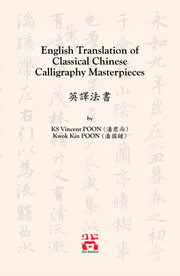A model of Cao Quan Stele (臨"曹全碑")
137 X 35cm (5)
Click to Enlarge. In Reserve, not available in Shop.
137 X 35cm (5)
Click to Enlarge. In Reserve, not available in Shop.
A model of Cao Quan Stele (臨 曹全碑)
137 X 35cm (5) in Clerical Script (隸書)
Historical information
(I)
Cao Quan Stele (曹全碑) was made and installed in 185AD to commemorate Cao Quan (曹全), a virtuous officer of the Eastern Han Dynasty. This stone stele was uncovered between 1573 to 1619 AD during the Ming Dynasty at the Heyang County of the Shaanxi Province (陝西郃陽).(1) Remarkably, the stele suffered minimal damage from the ages and, even up to now, most of its elegant inscribed characters remain intact and are clearly visible. It is hence today considered to be one of the most well-preserved Han clerical script (漢隸) works.(2) Further, the textual content chronicled various historical events in the late Eastern Han Dynasty and so is also regarded by some as an important primary source in studying the history of that period.(3)
(II)
The stele’s calligraphy is renowned for its refinement, elegance, liveliness as well as vigor (秀美飛動, 遒秀逸致).(4) It was once said that its elegance greatly influenced and gave rise to the exquisite standard script styles written by subsequent renowned calligraphers such as Ouyang Xun and Chu Suiliang (下開魏、齊、周、隋及歐、禇諸家楷法). (5) Despite its beauty and importance, the identity of the calligrapher remains unknown. The actual stone stele is currently retained in Xian’s Forest of Stone Steles (西安碑林), China.
Line-by-line English translation of Cao Quan Stele
(October 2018, by KS Vincent Poon)
Original Chinese
English translation
1. 君諱全,字景完,敦煌效穀人也。其先蓋周之胄。
2. 武王秉乾之機,翦伐殷商。
3. 既定爾勳,福祿攸同。封弟叔振鐸於曹國,因氏焉。
4. 秦漢之際,曹參夾輔王室。
5. 世宗廓土斥竟,子孫遷于雍州之郊。分止右扶風,或在安定,或處武都,或居隴西,或家敦煌。枝分葉布,所在爲雄。
6. 君高祖父敏,擧孝廉,武威長史、巴郡朐忍令、張掖居延都尉。
7. 曾祖父述,孝廉,謁者,金城長史,夏陽令,蜀郡西部都尉。
8. 祖父鳳,孝廉,張掖屬國都尉丞、右扶風隃麋侯相、金城西部都尉、北地太守。
9. 父琫,少貫名州郡。不幸早世,是以位不副德。
10. 君童齔好學,甄極毖緯,無文不綜。
11. 賢孝之性,根生於心。收養季祖母,供事繼母。
12. 先意承志,存亡之敬,禮無遺闕。
13. 是以鄉人為之諺曰:「重親致歡曹景完。」易世載德,不隕其名。
14. 及其從政,清擬夷齊,直慕史魚。
15. 歷郡右軄,上計掾史; 仍辟涼州,常為治中、別駕。
16. 紀綱萬里,朱紫不謬。
17. 出典諸郡,彈枉糾邪,貪暴洗心; 同僚服德,遠近憚威。
18. 建寧二年,舉孝廉,除郎中,拜西域戊部司馬。時䟽勒國王和德,弒父篡位,不供軄貢。
19. 君興師征討,有兗膿之仁,分醪之惠。攻城野戰,謀若涌泉;
20. 威牟諸賁,和德面縛歸死。還師振旅,諸國禮遺,且二百萬,悉以簿官。
21. 遷右扶風槐里令。遭同產弟憂,棄官。續遇禁网,潛隱家巷七年。
22. 光和六年,復舉孝廉。七年三月,除郎中,拜酒泉祿福長。
23. 訞賊張角,起兵幽、冀、兗、豫、荊、楊,同時並動。而縣民郭家等復造逆亂,燔燒城寺。萬民騷擾,人懷不安。三郡告急,羽檄仍至。
24. 于時聖主諮諏,群僚咸曰:君哉!轉拜郃陽令。收合餘燼,芟夷殘迸,絕其本根。
25. 遂訪故老, 商量㑺艾王敞、王畢等。恤民之要,存慰高年,撫育鰥寡。以家錢糴米粟,賜癃盲。
26. 大女桃婓等,合七首藥神明膏,親至離亭。部吏王皐、程橫等,賦與有疾者。咸蒙瘳悛。
27. 惠政之流,甚於置郵。百姓繈負,反者如雲。
28. 戢治廧屋,市肆列陳。風雨時節,歲獲豐年。農夫織婦,百工戴恩。
29. 縣前以河平元年遭白茅谷水災害,退於戌亥之閒。興造城郭。
30. 是後舊姓及脩身之士,官位不登。君乃閔縉紳之徒不濟,開南寺門,承望華𡽺。鄉明而治。
31. 庶使學者李儒、欒規、程寅等,各獲人爵之報。
32. 廓廣聽事官舍、廷曹廊閤、升降揖讓朝覲之階。費不出民,役不干時。
33. 門下掾王敞、錄事掾王畢、主簿王歷、戶曹掾秦尚、功曹史王顓等,嘉慕奚斯考甫之美。乃共刊石紀功, 其辭曰:
34. 懿明后,德義章。貢王庭,征鬼方。威布烈,安殊巟。
35. 還師旅,臨槐里。感孔懷,赴喪紀。嗟逆賊,燔城市。
36. 特受命,理殘圮。芟不臣,寧黔首。
37. 繕官寺,開南門。闕嵯峨,望華山。鄉明治,惠沾渥。
38. 吏樂政,民給足。君高升,極鼎足!
The Honorable Gentleman (君) had the first name given by his parents as Quan “全”, which was forbidden from mentioning by ordinary people (諱)(6). His “courtesy name” was Jingwan (景完). His ancestral home(7) was the county of Xiaogu (效穀縣), commandery of Dunhuang (敦煌郡). His ancestors were descendants of the Zhou imperial family.
FOR FURTHER TRANSLATION, FOOTNOTES, AND ELABORATIONS
PLEASE SEE :

English Translation of Classical Chinese Calligraphy Masterpieces 英譯法書
by KS Vincent POON and Kwok Kin POON (Feb. 2019)
ISBN 978-1-7753221-1-5
There are currently no satisfactory English translations of prominent classical Chinese calligraphy masterpieces (法書, exemplary works that are worth for all to study and observe) like Cao Quan Stele (曹全碑) and Lanting Xu (蘭亭帖). This is the first book that offers line-by-line English translations of the following five Chinese calligraphy masterpieces along with detailed annotations and explanations using historical reference books and texts:
- 1. Cao Quan Stele (曹全碑) by an unknown calligrapher (185AD);
- 2. Lanting Xu (蘭亭帖) by Wang Xizhi (王羲之, 303-361AD);
- 3. Elaborations on the Chronicle of Ni Kuan (兒寬贊帖) by Chu Suiliang (褚遂良, 596-658AD);
- 4. A Poem on General Pei (裴將軍帖) by Yan Zhenqing (顏真卿, 709- 785AD);
- 5. Huai Su’s Autobiography (懷素自叙帖) by Huai Su (懷素, 725-785 AD or 737-799 AD).
Previous attempts by renowned scholars such as Patricia Ebrey (in translating Cao Quan Stele) and LIN Yutang (林語堂, in translating Lanting Xu) contain significant errors and omissions and will be briefly discussed in this book. Hence, serious learners of Chinese calligraphy as well as scholars studying traditional Chinese culture will find this book particularly useful.
WORLDCAT/LIBRARY: [Worldcat] [Columbia U] [HKU] [CUHK] [Universiteit Antwerpen] [Wesleyan U] [Kyoto U] [National Taiwan U]
39. 中平二年十月丙辰造。